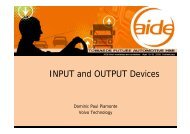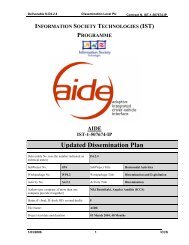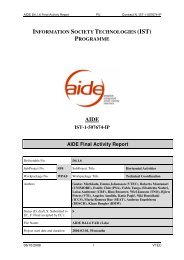download deliverable - AIDE
download deliverable - AIDE
download deliverable - AIDE
You also want an ePaper? Increase the reach of your titles
YUMPU automatically turns print PDFs into web optimized ePapers that Google loves.
Deliverable D4.2.1 Dissemination Level PU Contract N. IST-1-507674-IP<br />
3.9. Track I: <strong>AIDE</strong> Scenarios and Functions (morning session, attendance list can be<br />
found in Annex A)<br />
Chairman: Johan Engstrom, VOLVO<br />
Angelos Amditis, ICCS<br />
3.9.1. Summary<br />
A presentation of the adopted methodology towards the derivation of <strong>AIDE</strong> design<br />
scenarios was made. The key elements which, combined, constitute an <strong>AIDE</strong> design scenario<br />
description were addressed one by one. In order to explain the format of the scenarios’<br />
description, a description of the key terms used by subproject 3 of <strong>AIDE</strong> project was<br />
presented through the presentation of the <strong>AIDE</strong> glossary. More specifically, the following<br />
terms were discussed: <strong>AIDE</strong> design scenario, Driver-Vehicle-Environment conditions,<br />
Actions, <strong>AIDE</strong> meta-functions, driver distraction, driving demand, and application.<br />
The description of the adopted methodology involves mainly three of the<br />
aforementioned terms: Actions, Driver-Vehicle-Environment conditions and <strong>AIDE</strong><br />
metafunctions. The first two represent the driver-vehicle interaction in various driver-vehicleenvironment<br />
states, whereas the last one represents the system’s general solution to the<br />
possible action or condition depending conflict.<br />
3.9.2. Methodology adopted for the derivation of the <strong>AIDE</strong> design scenarios<br />
Having in mind the adaptive characteristics that <strong>AIDE</strong> project envisions to adopt<br />
towards a real-time adaptive HMI design and development, the design of the driver/vehicle<br />
dialogue should be based on clear scenario descriptions, able to represent not only the set of<br />
interactions between systems and the driver, but also the rationale behind system’s adaptivity.<br />
While standard use case templates are mainly intended for individual IVIS/ADAS functions<br />
(e.g. route guidance, phone, ACC, collision warning etc.), the <strong>AIDE</strong> system will implement<br />
“meta-functions” that supports the interaction between a large number of such functions and<br />
the driver (e.g. resolving conflicts between functions and enabling adaptation of individual<br />
functions). Thus, the standard use case methodology is not applicable. Still, in order to derive<br />
the <strong>AIDE</strong> requirements and specifications, we need a parsimonious way to describe the use<br />
cases and scenarios that <strong>AIDE</strong> will address. Such a methodology does not currently exist and<br />
thus had to be worked out in the project.<br />
Action categorization – required steps:<br />
• Define a set of basic parameters that can be used to characterize the actions<br />
<strong>AIDE</strong> action = f (initiator, duration, safety criticality, time criticality, real time,<br />
mandatory, driving relevance, preference)<br />
• Assign the parameters to the considered actions (list of 50 <strong>AIDE</strong> actions)<br />
• Three classes are derived from the in-vehicle HMI expert point of view considering<br />
the individual interaction content:<br />
•Warnings, which present very urgent information to the driver and which comes mainly<br />
from driving assistance systems like a lane departure warning system or collision avoidance<br />
25/07/2005 30 ICCS







